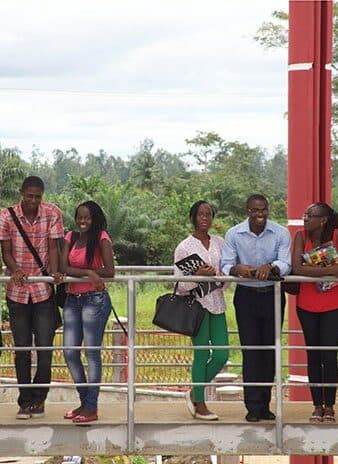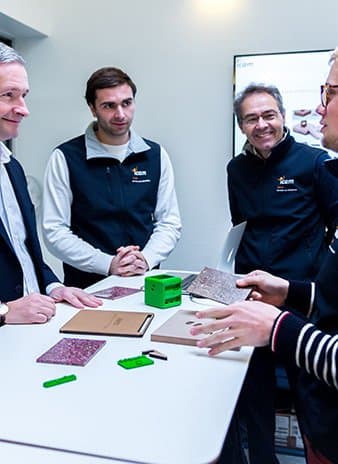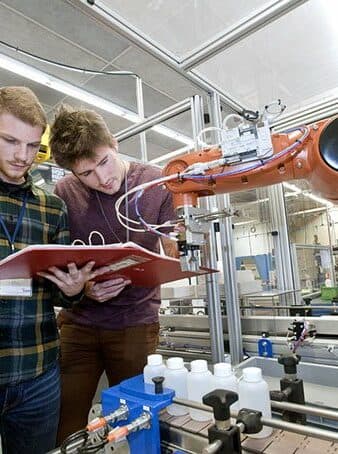Simulateur 3D pour la robotique autonome et connectée
Mémoire Scientique Recherche- Axe :
- Transition sociétale et technologique des entreprises
- Site :
- Lille
- Nature :
- Mémoire Scientique Recherche
- Personne(s) encadrante(s) :
- Allal SAADANE

Contexte et objectif du projet
L’équipe INCASE (GE-MIA) travaille sur plusieurs thématiques autour de l’Industrie du Futur dont la robotique autonome et connectée. On entend ici par robot autonome et connecté toute entité instrumentée et dotée d’un système de contrôle embarqué. De plus, elle est capable de communiquer et d’interagir en temps réel et à distance avec son environnement ou avec d’autres entités à distance.
Nous disposons au département GE-MIA de quelques robots mobiles pour la recherche et la pédagogie. Mais ils sont limités en nombre et en capacités.
L’objectif de ce travail, à terme, est de mettre au point un simulateur opérationnel pour construire des maquettes numériques sur mesure et contrôlables en ligne. L’accent sera mis en premier lieu sur:
- des modèles de robot avec son environnement de travail (bras manipulateur mobile ou fixe)
- véhicule de type voiture autonome intégrant une instrumentation de type ADAS[1]
Les applications immédiates attendues de cet outil sont:
- usage en Recherche: disposer d’une plateforme de validation d’algorithme de contrôle/commande avancée (robotique mobile et véhicules autonomes notamment) + actions de communication et de collaboration autour de ce thème.
- usage en R&D: outil d’étude de faisabilité et prototypage rapide
- usage pédagogique: mise à la disposition des élèves I4.7/8 et A4.8 pour les projets de synthèse
Architecture du simulateur
Le simulateur sera développé autour des plateformes logicielles suivantes:
- Matlab/Simulink pour l’implémentation des algorithmes de contrôle/commande temps réel
- V-REP : pour la création et simulation numériques de maquettes virtuelles ( partie opérative)
- SOLIDWORKS, pour le design de partie opérative 3D spécifique (le cas échéant)
L’image illustre l’architecture de principe du système à réaliser. Les parties logicielles “Interface” (Matlab) et “3D Simulation” (V-REP) peuvent cohabiter dans le même PC hôte ou tourner dans 2 PCs connectés par réseau Ethernet (TCP/IP). La partie HIL (Hardware In the Loop) sera étudiée par la suite.
Le travail demandé consiste à:
- Faire un état de l’art sur la simulation virtuelle 3D (native Matlab ou par logiciel compatible).
- S’approprier les fonctionnalités de Matlab/Simulink: le langage script Matlab et la toolbox de programmation graphique Simulink. De même que la toolbox ROS (Robotic Operating System)
- S’approprier l’environnement V-REP: programmation et création d’objet 3D
- En s’appuyant sur la littérature existante, réaliser une interface entre V-REP et Matlab/Simulink selon les deux technologies suivantes:
- utilisant le mode script Matlab
- utilisant les fonctions ROS sous Simulink
- Réaliser un premier prototype du simulateur 3D en s’appuyant sur le modèle du robot Kuka YouBot (dont on dispose d’un exemplaire à l’Icam)
- Réaliser un deuxième prototype d’un simulateur 3D avec comme partie opérative 2 véhicules à 4 roues (partant de modèles existant dans la littérature)
- Réaliser des tutoriels sur les développements réalisés
- Rédiger un rapport technique + une note de synthèse du travail réalisé
Par ailleurs, dans le cadre de ce travail, le binôme MSI sera appelé à déployer cette technologie et la mettre en oeuvre en encadrant des groupes d’élèves I4 ou/et A4 dans le cadre de leur projet de synthèse.
[1] ADAS: Advanced Driver Assistance SystemContext and objective of the project
The INCASE team (GE-MIA) is working on several themes around the Industry of the Future, including autonomous and connected robotics. The term “autonomous and connected robot” is used here to refer to any entity that is instrumented and equipped with an embedded control system. Moreover, it is able to communicate and interact in real time and remotely with its environment or with other remote entities.
In the GE-MIA department, we have some mobile robots for research and pedagogy. But they are limited in number and capacity.
The aim of this work, in the long term, is to develop an operational simulator to build custom digital models that can be controlled online. The initial focus will be on:
- robot models with its working environment (mobile or fixed manipulator arm)
autonomous car type vehicle integrating an ADAS type instrumentation [1].
The immediate applications expected from this tool are:
- Research use: to have a platform for validation of advanced control/command algorithms (mobile robotics and autonomous vehicles in particular) + communication and collaboration actions around this theme.
- For use in R&D: feasibility study and rapid prototyping tool.
- pedagogical use: making available to students I4.7/8 and A4.8 for synthesis projects
Simulator architecture
The simulator will be developed around the following software platforms:
- Matlab/Simulink for the implementation of real-time control algorithms
- V-REP : for the creation and numerical simulation of virtual models (operative part)
- SOLIDWORKS, for the design of specific 3D operating part (if applicable)
The picture illustrates the principle architecture of the system to be realized. The software parts “Interface” (Matlab) and “3D Simulation” (V-REP) can live together in the same host PC or run in 2 PCs connected by Ethernet network (TCP/IP). The HIL (Hardware In the Loop) part will be studied later.
The work required consists of:
- Make a state of the art on 3D virtual simulation (native Matlab or by compatible software).
- Get to grips with the functionalities of Matlab/Simulink: the Matlab scripting language and the Simulink graphical programming toolbox. As well as the ROS (Robotic Operating System) toolbox.
- Appropriating the V-REP environment: programming and creation of 3D objects
- Based on existing literature, create an interface between V-REP and Matlab/Simulink using the following two technologies:
- using Matlab scripting mode
- using SWR functions in Simulink
- Create a first prototype of the 3D simulator based on the model of the Kuka YouBot robot (of which we have a copy at the Icam).
- Realize a second prototype of a 3D simulator with 2 4-wheeled vehicles as operating part (based on models existing in the literature)
- Carry out tutorials on the developments carried out
- Write a technical report + a summary note of the work carried out
In addition, as part of this work, the MSI pair will be called upon to deploy this technology and implement it by supervising groups of I4 or/and A4 students as part of their synthesis project.
[1] ADAS: Advanced Driver Assistance System











